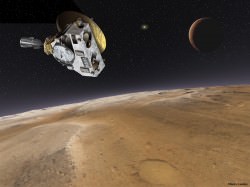A smash-up that created Pluto’s largest moon, Charon, likely sprayed debris four billion years ago that formed the genesis of the other moons scientists are spotting today, a new study concludes.
The find could explain why the satellites Styx, Nix, Kereberos and Hydra have orbital periods that are, respectively, just about exactly 3, 4, 5 and 6 times longer than Charon’s, scientists said.
“Any initially surviving satellites would likely be destroyed in collisions, but these shattered moons wouldn’t be lost; rather, their remains would stay in the Pluto/Charon system and become the starting point for building new satellites,” stated the Southwest Research Institute (SWRI), which led the study.

“In modeling the destruction of the satellites, the SWRI study found that there may be a method for moving them, or their building blocks, outward, due to the competing effects of Charon’s gravitational kicks and collisions among the debris of the disrupted satellites.”
Given Charon’s large size relative to Pluto (it’s a tenth of the dwarf planet’s size, compared to the Earth-Moon 81: 1 ratio), its large mass could easily perturb these smaller moons if they got close. Also, collisions between the debris could alter the orbits “to keep things away from Charon”, the scientists said.
Hopefully we will learn more when the NASA New Horizons spacecraft arrives at Pluto in 2015.
The findings were presented yesterday (Oct. 9) at the American Astronomical Association’s division of planetary sciences meeting in Denver; information on whether the results are peer-reviewed was not immediately available.
Source: Southwest Research Institute

